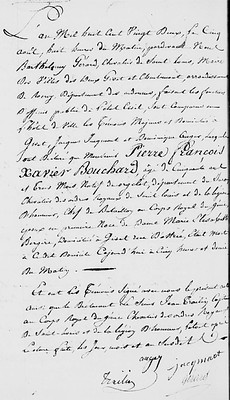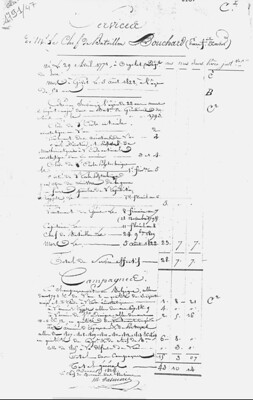Pierre Francois Xavier BOUCHARD (1771 - 1822)
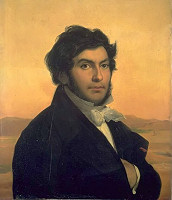 On May 10, 1831, in his opening speech for the archeology course at the College de France, Jean François Champollion expressed himself thus.
On May 10, 1831, in his opening speech for the archeology course at the College de France, Jean François Champollion expressed himself thus.
“An engineer officer, attached to the division of our army of Egypt which occupied the town of Rosette, Mr. Bouchard, found in August 1799 (it should in fact read July 1799 ) in excavations carried out at the old fort, a black granite stone, rectangular in shape, whose well polished face offered three inscriptions in three different characters. The upper inscription, largely destroyed or fractured, is in hieroglyphic script, the intermediate text belongs to a cursive Egyptian script and an inscription in Greek language and characters occupies the third and last division of the stone [13]. Here, clearly recounted, a considerable archaeological event which was to make it possible to decipher Egyptian writing - which no one had been able to read for fourteen centuries - at the end of a fantastic intellectual adventure.”
It is not useless to recall what was the existence of this officer of Bonaparte, who was at the origin of this overwhelming discovery.
______________________
 Pierre-François-Xavier Bouchard was born in Orgelet on April 29, 1771 [18] . His father, also named Pierre, originally from a family of carpenters in Montureux-les-Gray, and having successively occupied the professions of master carpenter, merchant, merchant and then teacher, married on November 25, 1756 [19] in our city , Pierrette Janet de Cressia, with whom he had seven children (4 girls and 3 boys) all born in Orgelet, Pierre being the youngest.
Pierre-François-Xavier Bouchard was born in Orgelet on April 29, 1771 [18] . His father, also named Pierre, originally from a family of carpenters in Montureux-les-Gray, and having successively occupied the professions of master carpenter, merchant, merchant and then teacher, married on November 25, 1756 [19] in our city , Pierrette Janet de Cressia, with whom he had seven children (4 girls and 3 boys) all born in Orgelet, Pierre being the youngest.
The future officer studied at the college of Orgelet until the class of rhetoric, then for two years he took courses in philosophy and mathematics at the college of Besançon [6] . He thus has all the knowledge to become a good engineer.
His military career began in 1793 as sergeant major in a battalion of Grenadiers de Paris. He is one of those famous "soldats de l'An II" and fights in Champagne and Belgium. But, on 25 thermior Year II (August 12, 1794) he requisitioned to be part of the aerostation company of Meudon [20] . Appointed lieutenant of balloonists (1795) he taught mathematics as deputy director at the National School of Aerostatics based in Chalais-Meudon.
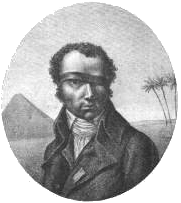 It was then that during an experiment under the direction of Nicolas Jacques Conté, (inventor of the artificial pencil Conté) who was trying to develop a process to produce hydrogen to inflate balloons observation [14] , he was injured by the explosion of a glass flask filled with hydrogen gas. Conté lost his left eye and Bouchard "hit himself dangerously had his right eye considerably weakened".
It was then that during an experiment under the direction of Nicolas Jacques Conté, (inventor of the artificial pencil Conté) who was trying to develop a process to produce hydrogen to inflate balloons observation [14] , he was injured by the explosion of a glass flask filled with hydrogen gas. Conté lost his left eye and Bouchard "hit himself dangerously had his right eye considerably weakened".
 Conté, who held him in very high esteem and was very close to the chemist Bertholet, one of the four founding fathers of the École Polytechnique, was no doubt no stranger to the admission of his protege to this school on November 21. 1796.
Conté, who held him in very high esteem and was very close to the chemist Bertholet, one of the four founding fathers of the École Polytechnique, was no doubt no stranger to the admission of his protege to this school on November 21. 1796.
His card on the list of students gives us a physical description of Pierre Bouchard: "1m78, brown eyes, brown hair, bare forehead, long nose, small mouth, round chin, long face" [4] .
There he followed the courses in descriptive geometry given by the famous mathematician Gaspard Monge and he learned the art of fortifications. But an unforeseen event would interrupt his studies: the Minister of War called on Lieutenant Bouchard for public service and assigned him on April 20, 1798 to the Egyptian expeditionary force.
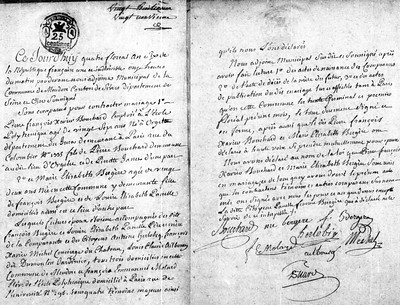 Our Orgelètain married on April 23, before embarking, a young woman from Meudon five years his junior, Marie Élisabeth Bergère, who ran the sewing workshop for balloon envelopes at the School of Aerostatics [4] . They will later have two children.
Our Orgelètain married on April 23, before embarking, a young woman from Meudon five years his junior, Marie Élisabeth Bergère, who ran the sewing workshop for balloon envelopes at the School of Aerostatics [4] . They will later have two children.
On May 19, having reached the port of Toulon, he cast off on the "Franklin". Part of the team of "scholars" who landed in Egypt on July 4 after the capture of Alexandria, he was appointed member of the Commission of Sciences and Arts. Always placed under the authority of Conté, he was assigned to the group of mechanical artists and charged with investigating the techniques and trades of the Egyptians.
Then he left Alexandria on September 7 for Cairo where he only stayed a few weeks. On October 3, we find him under the orders of General Andreossy in a team of geographers to do the reconnaissance of Lake Menzale between Damietta and Port-Saïd [9] . This mission only lasted forty days for him because he had to appear without delay before the exit jury of the École Polytechnique chaired by Monge, which he did in mid-November. He was then promoted to lieutenant second class in the Engineers on November 28, 1798 and left the Commission of Sciences and Arts to join the army.
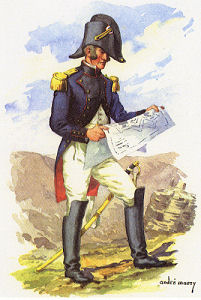 The immediate continuation of his military career is not clearly established in his file but following cross-checks it is possible to formulate a hypothesis.
The immediate continuation of his military career is not clearly established in his file but following cross-checks it is possible to formulate a hypothesis.
Indeed, on October 31, 1798, Bonaparte having decided, to ensure the defense of the city of Rachid, (in French Rosette) to repair an old fortification designated under the name of Borg Rachid (baptized Fort Julien by the French in memory of an aide-de-camp of Bonparte killed in the region in July 1797), it seems that Bouchard was, as soon as he was appointed to the Engineers, assigned to this task to lend a hand to Captain Dhautpoul.
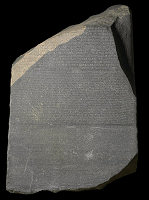 And it is there that in July 1799, on the left bank of the western branch of the Nile, the famous Black Stone was unearthed, during earthworks carried out in old substructures. In the current state of knowledge it seems difficult to further specify the exact date, often set at July 19, but we can consider a date between the 14 and the 25 as probable.
And it is there that in July 1799, on the left bank of the western branch of the Nile, the famous Black Stone was unearthed, during earthworks carried out in old substructures. In the current state of knowledge it seems difficult to further specify the exact date, often set at July 19, but we can consider a date between the 14 and the 25 as probable.
Bouchard was immediately convinced of the importance of his discovery. General Menou, who then commanded the district of Alexandria and Rosette, immediately had a translation of the Greek text established. The official declaration of the discovery, revealed in the "Courrier de l'Egypte", the army press organ, did not appear until September 15, 1799 [12] , that is to say the very day of the return of Bonaparte in France. In the meantime Bouchard had been given the task of transporting the stone, which was handed over in mid-August to the Institute of Egypt, where fingerprints were taken without delay to facilitate the study of the precious document.
Thanks to the copies made, the discovery was disseminated in France [10] [11] and across Europe, Bonaparte himself announcing on October 27 the forthcoming arrival in Paris of the Stone, thus placing the event at the forefront of the results. of his Egyptian adventure. But alas the military setbacks of France confronted with the ambitions of its English rival would lead to the seizure of the Stone by the latter and its transfer to the British Museum.
At the same time, Pierre Bouchard found himself embroiled in the deplorable imbroglio which led to the fall of the fort of El-Arish, for which he was responsible, under the orders of General Cazals, for the defense against the Turks. Sent as a parliamentarian to the Grand Vizier, he was arrested, disarmed and taken into captivity in the prisons of Damascus where he stayed for forty-two days. Released then promoted to captain on May 1, 1800, he was assigned a second time to Rosette and taken prisoner again during the capitulation of Fort Julien, defended by a handful of able-bodied soldiers against the attack of two thousand English combined with that of four thousand Turks. It would unfortunately take too long in this enumeration of facts to place them precisely in the litany of the vicissitudes of the Egyptian campaign.
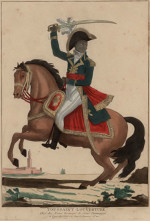 Returning to Marseilles on July 30, 1801, Bouchard, having kept a taste for adventure, was admitted to take part in the "Colonies" expedition to Saint-Domingue, pearl of the French West Indies, where the revolution was rumbling. Embarked in December, he is therefore involved in an operation consisting in reframing the action of the black general, Dominique Toussaint dit Toussaint Louverture , who at the head of the black population of Haiti has made himself master of the island and governs in name of the French Republic.
Returning to Marseilles on July 30, 1801, Bouchard, having kept a taste for adventure, was admitted to take part in the "Colonies" expedition to Saint-Domingue, pearl of the French West Indies, where the revolution was rumbling. Embarked in December, he is therefore involved in an operation consisting in reframing the action of the black general, Dominique Toussaint dit Toussaint Louverture , who at the head of the black population of Haiti has made himself master of the island and governs in name of the French Republic. 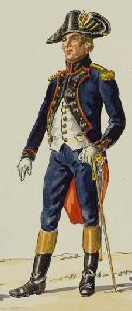 Doubtless Bouchard believed in a military parade. His wife accompanies him, imitating him in this, but at his expense, Pauline Bonaparte, wife of General Leclerc, commander-in-chief of the expeditionary force.
Doubtless Bouchard believed in a military parade. His wife accompanies him, imitating him in this, but at his expense, Pauline Bonaparte, wife of General Leclerc, commander-in-chief of the expeditionary force.
Adding to the difficulties due to the guerrillas and the devastating action of yellow fever, France decided to reestablish slavery abolished by the new masters of the colony. The campaign was appalling. Of the thirty-five thousand men of the LECLERC expedition, twenty-one thousand died of disease, seven thousand were killed in the fighting. BOUCHARD like his wife did not escape the attacks of yellow fever, but a little girl was born to them in 1802 without it being known whether Madame BOUCHARD had been repatriated before.
The reinforcements sent to the island and the replacement of LECLERC, who died in November 1802, by ROCHAMBEAU solved nothing. Moreover, the breaking of the Peace of Amiens in May 1803 gave the English the excuse of blockading the island. France is reduced to capitulation. BOUCHARD is taken prisoner for the third time. Interned in Jamaica, he was released on parole in August 1804 and returned to France.
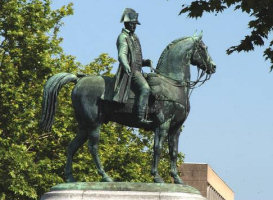 After a few months of convalescence, we find him in September 1805 in Napoléon Vendée which will later be called La Roche-sur-Yon. He is in charge of construction work in this city, created from scratch by the Emperor to restore civil and military authority over a population for which the presence of English frigates at sea still aroused some nostalgia. He stays there for two years with his wife, who will give birth to a son before the builder gives way again to the soldier.
After a few months of convalescence, we find him in September 1805 in Napoléon Vendée which will later be called La Roche-sur-Yon. He is in charge of construction work in this city, created from scratch by the Emperor to restore civil and military authority over a population for which the presence of English frigates at sea still aroused some nostalgia. He stays there for two years with his wife, who will give birth to a son before the builder gives way again to the soldier.
 After a brief stay in La Rochelle, BOUCHARD joined in 1807 an expeditionary force that Napoleon, after the Treaty of Tilsitt, directed against Spain and Portugal. Then began for him seven years of war where he served successively under DUPONT, SOULT, MASSENA and MARMONT. He distinguished himself at the Battle of Alcolea on the Guadalquivir. However after the capitulation of DUPONT in Baylen (July 22, 1808) he was taken prisoner again but upon his release he managed to join the army of SOULT.
After a brief stay in La Rochelle, BOUCHARD joined in 1807 an expeditionary force that Napoleon, after the Treaty of Tilsitt, directed against Spain and Portugal. Then began for him seven years of war where he served successively under DUPONT, SOULT, MASSENA and MARMONT. He distinguished himself at the Battle of Alcolea on the Guadalquivir. However after the capitulation of DUPONT in Baylen (July 22, 1808) he was taken prisoner again but upon his release he managed to join the army of SOULT.
He commanded the engineers of the 1st division [16] of the French army during the second invasion of Portugal in 1809. Present at the battle of Corunna and the capture of Oporto , he distinguished himself at the head of the sappers during the crossing the fortified bridge of Amarante [17] .
BOUCHARD was promoted battalion commander on November 24, 1809, despite everything leaving his wife in the greatest misery and forced to request an advance of 500 francs on the pay of her husband, entirely devoted by the latter to re-equip and acquire new horses to following the evacuation of Portugal by French troops.
In 1810 and 1811 he fought under the orders of MASSENA in a new expedition to Portugal, once again ending in a retreat. Appointed Knight of the Legion of Honor on August 6, 1811 [21] , he was then assigned to the defense of Astorga in Spain under the orders of MARMONT then of CLAUZEL he was taken prisoner a fifth time during the capitulation of this city fortified. Sent to detention in England in September 1812, he leaves his two children and his parents-in-law in the care of his wife, again destitute of resources.
He will not return to France until after the Treaty of Paris in July 1814. The Restoration then brings him satisfaction. Promoted to Officer of the Legion of Honor [15] , he was also named Chevalier de Saint Louis.
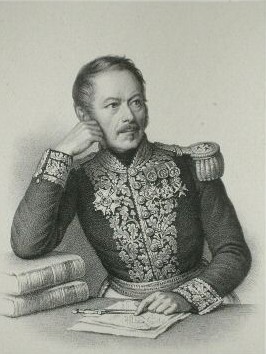 He commanded the Engineers of Orléans, but during the Hundred Days he returned to the service of Napoleon who charged him with the defense of the city of Laon. Denounced after Waterloo for his positions favorable to the "usurper" he was put on half pay but in July 1816 asked for a review of his file by minimizing his role during the "interregnum". He then resumed service, assigned to the fortified towns of northern France. Noted as "as recommendable by his morality as by his education", he was proposed by his classmate PREVOST de VERNOIS for the rank of lieutenant colonel, but assigned to the post of Chief Engineer at Givet in 1822, he died there on August 5 [22] following a long and painful illness some time after the death at the age of 13 of his son, a very brilliant subject.
He commanded the Engineers of Orléans, but during the Hundred Days he returned to the service of Napoleon who charged him with the defense of the city of Laon. Denounced after Waterloo for his positions favorable to the "usurper" he was put on half pay but in July 1816 asked for a review of his file by minimizing his role during the "interregnum". He then resumed service, assigned to the fortified towns of northern France. Noted as "as recommendable by his morality as by his education", he was proposed by his classmate PREVOST de VERNOIS for the rank of lieutenant colonel, but assigned to the post of Chief Engineer at Givet in 1822, he died there on August 5 [22] following a long and painful illness some time after the death at the age of 13 of his son, a very brilliant subject.
Pierre BOUCHARD then lacked a few months of service to reach the age of thirty allowing his wife to claim a pension. She calls for help. The friends mobilized and acknowledging the benefit of "eminent services" to the interested party, the Council of State and the War Committee proposed to the King to grant his widow a pension of four hundred and fifty francs corresponding to a quarter of that to which her husband could have claimed.
Here, too briefly summed up, is the life of a probably brilliant but self-effacing Orgelètain, from a modest background, more of an engineer than a soldier, but not lacking in courage and a sense of duty.
Released from anonymity by the international impact of a fortuitous discovery, he will die while CHAMPOLLION was writing the letter by which he was going to communicate to the Academy of Inscriptions and Belles Lettres on September 27, the result of his long years of work. And we had to wait until May 1991 for BOUCHARD's birth certificate to come out in Orgelet.
Despite extensive research, carried out by the "Musée du Génie" located in the premises of the École Supérieure d'Application du Génie in Angers, it has not been possible to date to find any trace of a portrait of Pierre BOUCHARD. . And it's a pity because it is not excluded that the latter appears on the drawings or paintings painted during the Egyptian campaign by the sappers placed under the orders of CONTE, himself an excellent portraitist, recognizable for this which concerns him with the presence of a blindfold over his left eye.
Annie and Guy BIDARD - Traduction : François Bonneville
Sources and bibliography
- [1] Société française d'Égyptologie - Bulletin n°146 d'Octobre 1999
- [2] La Pierre de Rosette - Robert SOLE, Dominique VALBELLE - Éditions du Seuil - Mai 1999
- [3] Bonaparte en Égypte ou le rêve assouvi- Jacques BENOIST-MECHIN - Librairie académique PERRIN
- [4] La Jaune et la Rouge - Revue de l'École Polytechnique - Avril 1991 - Libres propos : Pierre BOUCHARD, soldat et ingénieur, inventeur de la Pierre de Rosette par Jacques LAURENS X 38
- [5] Le lieutenant Bouchard (X1796), découvreur de la pierre de Rosette - Ahmed YOUSSEF - La Jaune et la Rouge - Revue de l'École Polytechnique n°766 - Juin 2021
- [6] Lettre du général B. RICHE au maire d'Orgelet, en date du 8 octobre 1992
- [7] La pierre du lieutenant inconnu, Frédéric Chevalier, Pays Comtois n°73 ISSN 1266-1341, Juillet 2007, pp.86-87.
- [8] La chute d'El-Arich, décembre 1799 : Journal historique du Capitaine Bouchard, preface and notes by Gaston Wiet, éditions de la Revue du Caire, 1945, 176 pages.
- [9] Le moniteur universel, 12 octobre 1999, page 1
- [10] Le moniteur universel, 16 janvier 1800, page 2
- [11] Le journal de Paris, 17 janvier 1800, page 3
- [14] Les grands noms de l’Aérostation à Meudon, Lettre de l’Association Aéronautique Astronautique de France, n°41, Janvier 2020
- [15] Fiche de Pierre Bouchard dans la base Léonore de la Légion d'Honneur
- [16] Mémoires sur les opérations militaires des Français en Galice, en Portugal et dans la vallée du Tage en 1809 sous le commandement du Maréchal Soult, Pierre-Madeleine Le Noble, édité chez Barrois l'Ainé à Paris en 1821
- [17] Souvenirs militaires du temps de l'empire, par un officier supérieur du deuxième corps. Tome Ier. 1841, p 213
- [18] Registres paroissiaux d'Orgelet, cote Acnum13/8, Archives départementales du Jura
- [19] Registres paroissiaux d'Orgelet, cote Acnum13/10, Archives départementales du Jura
- [20] Arrêté mettant en réquisition Bouchard pour faire partie de la compagnie d'aérostation de Meudon, an II, 25 thermidor - Archives du pouvoir exécutif : Conseil exécutif provisoire, Convention, Comité de salut public. Vol. 5 AF/II/198-AF/II/280 - Archives Nationales
- [21] Revue du génie militaire - 1896 - Volume 12 - Page 134
- [22] Registre d'état-civil de Givet, Archives départementales des Ardennes

